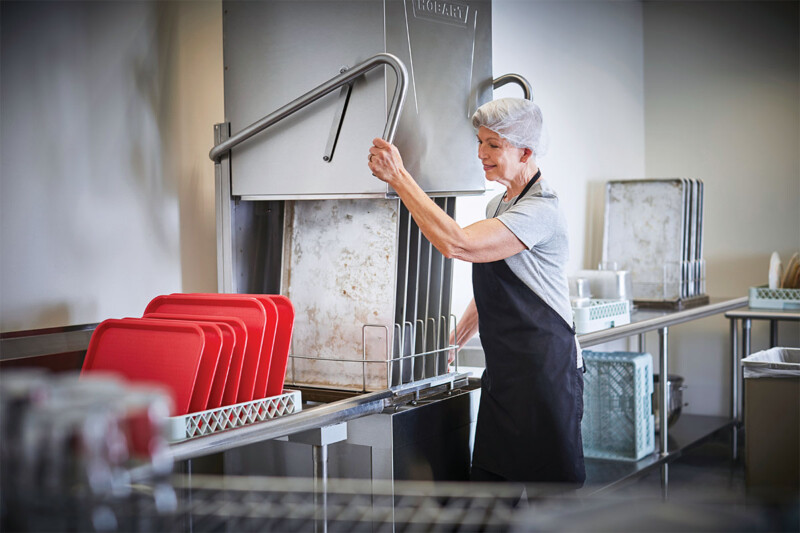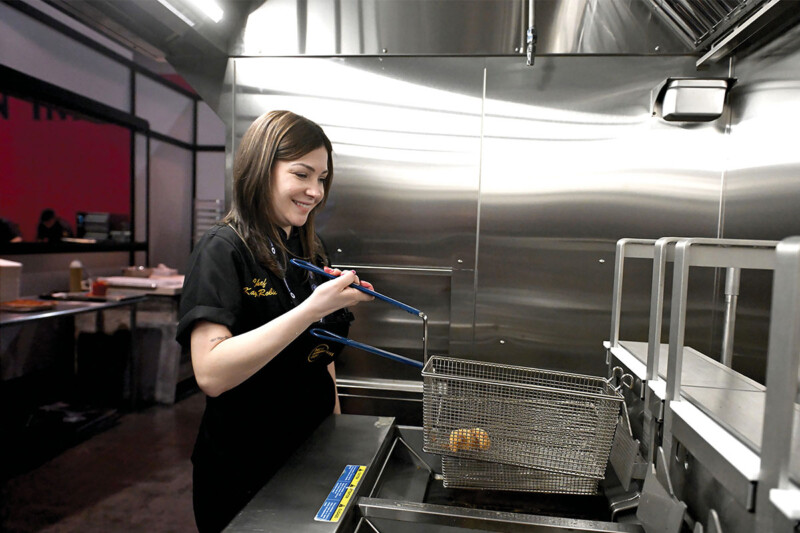Flight-type warewashers are critical to the success of the large kitchen operations they support, so it makes sense to take care of yours. Training staff to perform daily and periodic maintenance properly and scheduling regular tune-ups with an authorized technician will help your machine run longer and require fewer service calls. It’s ironic—but true—that some of your lowest-paid employees operate one of your most expensive pieces of equipment. Ongoing training is mandatory if you expect your flight-type warewasher to last.
Daily Procedures:
Your dishroom crew needs to completely drain the prewash and wash tanks between meal periods or at the very least, at the end of the day, depending on your volume. Keeping your tank water relatively clear will ensure clean dishes and make effective use of your detergent. If your staff fails to change the water when needed, they will be washing your wares with dirty water.
Empty and wash the scrap screens or baskets in each wash section daily, and make sure the crew knows where and how to put each screen and basket back in place. These filters capture and keep bulk food soil out of the water and the warewasher’s mechanical workings. If soil gets into your tanks and pumps, it can jam the works and clog wash arms so they won’t clean your dishes properly.
Inspect and clean the wash arms daily. The nozzles on the wash arms are engineered to spray in a specific pattern so the wares get optimal water coverage throughout the machine. Check the nozzles by opening the tank and pulling out the wash arms. If you see food particles inside, clear them out.
Part of your daily routine also needs to include washing the strip curtains at the load end, hosing out the machine, wiping down horizontal surfaces and leaving the doors open overnight so the interior can dry.
Periodic Maintenance:
Beyond daily procedures, your dishmachine requires certain periodic upkeep. For starters, if you use a newer model with a heat-recovery system that improves efficiency and lowers operating costs, you’ll want to clean the extraction fan and heat exchanger for optimal performance. Try warm, soapy water or a degreaser to clean the exchanger blades.
Regularly read your machine’s water-pressure and water temperature gauges. Correct water pressure (about 20 psi) ensures the machine effectively removes soil from dishes. If your machine doesn’t include a heat-recovery system, make sure the water comes into the machine at 140°F; if it doesn’t, the internal booster heater will have to work harder to bring the final sanitizing rinse to 180°F, and this may eventually cause the booster to fail. Machines using heat-recovery systems initially fill wash tanks with hot water but then run on a cold-water feed as low as 50°F and rely on a smart booster heater to achieve the 180°F final sanitizing rinse.
Depending on your water quality, your machine may require deliming. Ignore this step, and the lime scale can do a number on your unit’s heating elements and pump seals. Generally, a machine in a hard-water environment requires deliming once a month. During the deliming process, make sure to remove the final-rinse wash arm and place it in the deliming solution.
Ongoing Service, Training:
Hire an authorized service tech to install the machine correctly in the first place; then call them in for an annual thorough inspection of the unit. They’ll want to check all components, clean pump screens and replace seals as needed.
Meanwhile, keep your owner’s manual handy. Don’t leave it unopened and buried in your office somewhere.
Don’t underestimate ongoing, hands-on training for your employees either; dishrooms have a high turnover rate. Invite a service agent or detergent provider to train staffers. Post step-by-step care instructions on the unit using graphics and oversized lettering.
Copyright FER June 2015
RELATED CONTENT
- Advertisement -
- Advertisement -
- Advertisement -
TRENDING NOW
- Advertisement -
- Advertisement -
- Advertisement -


